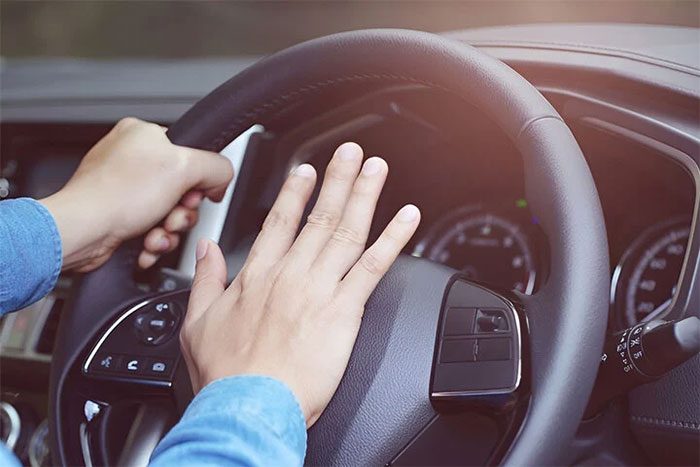Dr. Hoàng Ngọc Tân – Head of the Automotive Engineering Department at Lac Hong University – stated that there are some simple principles that preschool children can be taught and implemented in the unfortunate event of being forgotten in a car or shuttle.
1. Sound the Car Horn
With most modern vehicles, even if the engine is off, the key is removed, or the key is far away from the car, the horn can still be sounded. This is because the car horn uses a power source directly connected to the battery. The battery can provide power for the horn to sound continuously for many hours.

Teaching children how to honk the car horn – (Photo: internet).
Therefore, teachers, caregivers, or parents should show children the location of the car horn and how to honk it.
In the event that a child is left in the car without any means of external communication, they should go to the horn’s location and honk it continuously to attract the attention of those around them. This is a simple and low-effort method that almost any child can perform if instructed beforehand.
2. Activate the Hazard Lights

Activating the hazard lights to attract attention – (Photo: CARANDBIKE).
Similar to the horn, the hazard lights can still function when the car is turned off, even if it is locked from the outside. Simply pressing the button will cause the hazard lights located at the front and rear corners of the vehicle to flash continuously. Some vehicles even emit a sound, helping to draw attention from people nearby.
The hazard light button on the vehicle’s control panel is easily recognizable with a white triangle on a red background. Teachers and parents can easily guide children to the location of this button and how to press it. Children can also combine activating the hazard lights with honking the horn.
3. Locate the Unlock Button at the Driver’s Seat

Unlock and lock button symbols at the driver’s seat that children can look for – (Photo: fordservicecontent.com).
If the car is parked in an area with few or no people around, children should seek out the buttons on the side of the driver’s seat. Many modern vehicles have two buttons shaped like an open and closed lock. Children just need to press the open lock button, then pull the door handle outward and push to open the door.
Currently, most vehicles can be unlocked from the inside. Some newer models will also lower the car window when the unlock button is pressed, providing another escape route for children.
This button at the driver’s seat is usually easy to identify, and children can practice using it a couple of times to learn how to operate it. In some vehicles, the passenger seat may also have similar buttons.
|
Be Cautious with Children Sleeping in Cars The three escape methods mentioned above will be effective when children are awake; however, the most dangerous situation is when a child falls asleep in the car. As oxygen levels decrease and the temperature in the car rises rapidly, it can lead to difficulties in breathing, suffocation, and even fatalities in some cases. The risk of suffocation is higher in smaller vehicles if a child is forgotten inside. Some new electric vehicle models are equipped with occupancy sensors. These sensors can detect if someone is seated in the car, functioning similarly to seatbelt sensors. When the sensor detects that someone is still in the car, it will prevent the doors from locking. However, this feature is not available in buses or passenger vans. Therefore, the observance of adults before leaving the vehicle is crucial. In school shuttle buses, drivers or caregivers should take a few extra minutes to thoroughly check the seats and cross-check the number of children before and after disembarking to avoid situations where children remain in the car due to sleeping. Nearly 1,000 Children Have Died in the U.S. Data from the National Highway Traffic Safety Administration shows that since 1998, there have been 971 cases of children being left in cars that resulted in heatstroke fatalities in the U.S. Among these, 505 children were unintentionally forgotten, 237 children entered the car without adult supervision, and 200 children were intentionally left in cars. Every year, approximately 37 children under the age of 15 die from heatstroke due to being left in cars in the U.S. |


















































